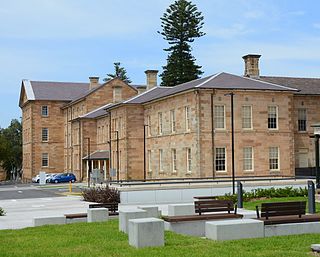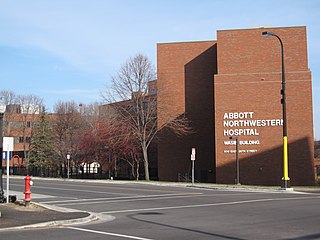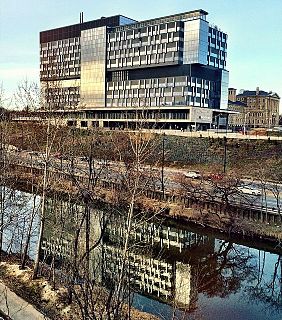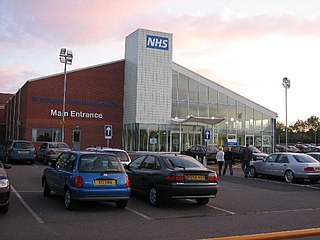The UK statutory notification system for infectious diseases is a system whereby doctors are required to notify a "proper officer" of the local authority if they are presented with a case of a serious infectious disease such as diphtheria or measles. The proper officer then sends a report to the Centre for Infections of the Health Protection Agency (HPA) in Colindale, north London.

Royal Perth Hospital (RPH) is a 450-bed adult and teaching hospital located on the northeastern edge of the central business district of Perth, Western Australia.

The Prince of Wales Hospital is a 440-bed major public teaching hospital located in Sydney's eastern suburb of Randwick, providing a full range of hospital services to the people of New South Wales, Australia. The hospital has strong ties to the University of New South Wales. The Prince of Wales Hospital shares the Randwick Hospitals' Campus site with the Royal Hospital for Women and the Sydney Children's Hospital, as well as the Prince of Wales Private Hospital.

Walkergate is an area and electoral ward in the city of Newcastle upon Tyne, England. It is in the east of the city, north of Walker proper, east of the Heaton area and west of Wallsend. Areas within the Walkergate ward include Daisy Hill, Eastfield, Walkerdene and Walkerville. Walkergate Metro station which was opened in 1982 serves the area. This replaced the previous railway station on the same site which was originally known as Walker station from 1839 to 1889 when it was renamed Walker Gate station.

Vancouver General Hospital is a medical facility located in Vancouver, British Columbia. It is the largest facility in the Vancouver Hospital and Health Sciences Centre (VHHSC) group of medical facilities. VGH is Canada's third largest hospital by bed count, after Hamilton General Hospital, and Foothills Medical Centre.
Lismore Base Hospital is a major public teaching hospital in the Northern Rivers region of New South Wales, Australia, located in the city of Lismore. It has approximately 260 beds, and serves as the primary hospital and recognised trauma centre for the Northern New South Wales Local Health District. Due to its size and location, the hospital also serves as a rural teaching hospital for many universities based in metropolitan New South Wales and Queensland. Its primary referral area consists of the Clarence and Richmond valleys, which has a population of approximately 180,000 people.

NYU Langone Health is an academic medical center located in New York City, New York, United States, affiliated with New York University. NYU Langone comprises NYU Grossman School of Medicine and several inpatient facilities: Tisch Hospital, Kimmel Pavilion, NYU Langone Orthopedic Hospital, Hassenfeld Children's Hospital, NYU Langone Hospital-Brooklyn and NYU Langone Hospital-Long Island. It is also home to Rusk Rehabilitation. NYU Langone Health operates over 350 locations in the New York area. The Manhattan campus of NYU Langone Health overlooks the East River.

Fairfield Infectious Diseases Hospital, originally known as Queens Memorial Infectious Diseases Hospital, operated from 1904 to its closure in 1996. Perched high on the banks of the Yarra River at Yarra Bend in the inner Melbourne suburb of Fairfield, it developed an international reputation for the research and treatment of infectious diseases. When it closed, it was the last specific infectious diseases hospital in Australia.

Westchester Medical Center University Hospital (WMC), formerly Grasslands Hospital, is an 895-bed Regional Trauma Center providing health services to residents of the Hudson Valley, northern New Jersey, and southern Connecticut. It is known for having one of the highest case mix index rates of all hospitals in the United States. 652 beds are at the hospital's primary location in Valhalla, while the other 243 beds are at the MidHudson Regional Hospital campus in Poughkeepsie. It is organized as Westchester County Health Care Corporation, and is a New York State public-benefit corporation.

Abbott Northwestern Hospital is a 686-staffed bed teaching and specialty hospital based in Minneapolis, Minnesota. It is a part of the Allina Health network of hospitals and clinics.

Hennick Bridgepoint Hospital, formerly Bridgepoint Active Healthcare, is a complex care and rehabilitation hospital in Toronto. It is a member of the Sinai Health System and affiliated with the University of Toronto
George Pearson Centre is a long term residential care facility located in the Marpole neighbourhood of Vancouver, B.C., Canada and is currently owned and operated by Vancouver Coastal Health. George Pearson Centre was named after former BC Minister of Health, George S. Pearson. Built in 1952 to originally treat tuberculosis patients and then polio patients, in the 1960s the focus of George Pearson Centre changed to long term care for adults with disabilities.

The Ellis Island Immigrant Hospital was a United States Public Health Service hospital on Ellis Island in New York Harbor, which operated from 1902 to 1951. The hospital is part of the Statue of Liberty National Monument. While the monument is managed by the National Park Service as part of the National Parks of New York Harbor office, the south side of Ellis Island, including the hospital, is managed by the non-profit Save Ellis Island Foundation and has been off-limits to the general public since its closing in 1954.

Ruchill Hospital was a fever hospital in the Ruchill area of Glasgow, Scotland. The hospital was closed in 1998 and was sold to Scottish Enterprise in July 1999. It was managed by NHS Greater Glasgow.
The town of Colorado Springs, Colorado played an important role in the history of tuberculosis in the era before antituberculosis drugs and vaccines. Tuberculosis management before this era was difficult and often of limited effect. In the 19th century, a movement for tuberculosis treatment in hospital-like facilities called sanatoriums became prominent, especially in Europe and North America. Thus people sought tuberculosis treatment in Colorado Springs because of its dry climate and fresh mountain air. Some people stayed in boarding houses, while others sought the hospital-like facilities of sanatoriums. In the 1880s and 1890s, it is estimated that one-third of the people living in Colorado Springs had tuberculosis. The number of sanatoriums and hospitals increased into the twentieth century. During World War II, medicines were developed that successfully treated tuberculosis and by the late 1940s specialized tuberculosis treatment facilities were no longer needed.
Barnes Hospital, on South Worple Way, East Sheen, in the London Borough of Richmond upon Thames, is a hospital managed by South West London and St George's Mental Health NHS Trust. It provides community and inpatient mental health services.

Heartlands Hospital is an acute general hospital in Bordesley Green, Birmingham, England. It is managed by University Hospitals Birmingham NHS Foundation Trust.
The Detroit Health Department has provided public health services, and has partnered with neighborhoods and community stakeholders, for over 100 years. The department was able to grow from its focus on communicable diseases to one that had over 40 programs and services at one point. When budgets began to deteriorate, many of those programs and services ended. With the city on the verge of bankruptcy, most of the department's remaining services were contracted out to a private agency, the Institute for Population Health (IPH). However, upon successful progress post-bankruptcy the City of Detroit was able to take control of many of the services that were transitioned to IPH in 2014 and 2015. In 2015, Mayor Mike Duggan hired Dr Abdul El-Sayed to run the department, and he stayed in that role for a little over a year before leaving to run for Governor of Michigan. In February 2017, Dr. Joneigh Khaldun, a practicing emergency physician and former Chief Medical Officer of the Baltimore City Health Department, was appointed to lead the department.

The Edinburgh City Hospital was a hospital in Colinton, Edinburgh, opened in 1903 for the treatment of infectious diseases. As the pattern of infectious disease changed, the need for in-patients facilities to treat them diminished. While still remaining the regional centre for infectious disease, in the latter half of the 20th century the hospital facilities diversified with specialist units established for respiratory disease, ear, nose and throat surgery, maxillo-facial surgery, care of the elderly and latterly HIV/AIDS. The hospital closed in 1999 and was redeveloped as residential housing, known as Greenbank Village.














